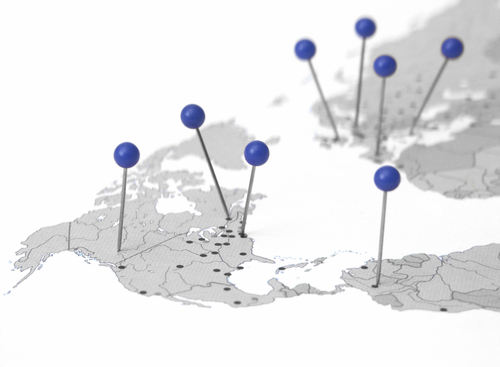"...one of the most overlooked techniques for companies to employ.”
INTRO
I've long wanted to write a post about "Talent Maps", which I see as a tool, as well as a strategic part of Recruiting and Sourcing. This post was triggered by several recent interactions with colleagues.
Apparently, in the UK, as well as in Australia and New Zealand, Recruiters are fans of “Talent Maps” (also dubbed as “Market Maps”). Unsurprisingly, definitions vary. However, Talent Maps don’t seem to be a popular way to Source and Research here in the US or in Canada. I wonder why! It’s known here and there, but there’s not much discussion on that; and, simple Googling would mostly take you away from North America.
Should companies in the US include “Talent Mapping” as a best practice? Would there be a market for those services, to cut recruiting costs? I am especially interested to hear from those who have heard about Talent Maps but haven’t implemented in practice.
TALENT MAPS - ONLINE
Here is a definition from a UK-based site:
Market Mapping/ Talent Mapping: this involves delivery of a robust map of your competitors within defined target organisations, further broken down into segmented groups or teams[…] identifying target pools of candidates according to your set criteria, for example by title, seniority or location […]
Here’s from an Australian site:
Talent Mapping is the targeted identification and engagement of people with skills to fill both existing, newly created and future roles in your organization. […]
As you can already see from the definitions, Talent Mapping is not “just” Sourcing or “Pipelining” for a role. It is also Competitive Intelligence Research, and reveals the big picture, along with identifying target professionals.
TALENT MAPS - AT CONFERENCES
I’d like to share some observations "from the field".
Based on our interactions with several attending Recruiters and Managers at the recent Sourcing Summit, Talent Maps sound like a common practice for both corporate recruiters and agency recruiters (those who get repeated business). There are also firms specifically producing Talent Maps on demand.
“Talent Maps”, as an Australian colleague told us, are often stored in excel files, listing professionals with contact info, roles, companies, locations, some social links, some news info, and some sort of a status for each. However (as opposed to an output for a Sourcing Project for a role), Maps include “everyone” (not just some target professionals), for a given specific background. Updates with a “may be ready to make a move” status are made on a regular basis; those often simply come from networking (calls, emails).
These Maps serve as pipelines for repeated recruitment requests - but with the additional quality that they cover pretty much everyone for an industry/location/seniority/job title combination. Because of that, Maps also serve as a source of Competitive Intelligence. They provide: full identification of competitors; their locations (i.e. where the talent is/isn’t); “mapping” for the titles for similar job roles across competitors; and industry news summaries, as to what the competition is doing (hiring/firing/restructuring, etc.)
To provide for a more complete description, the Talent Map data can include other fields, such as: salaries; moves and promotions; and some reporting structure. In addition to some table data, a Map can include data in different formats, such as graphical representations, geographical maps, or org charts. (Of course, creating organizational charts for is different from Talent Mapping – that would include profiling “everyone” for a company vs. “everyone” for a role.)
TALENT MAPS - HANDS-ON EXPERIENCE
My recent Sourcing Project was finding “everyone” in a specific executive role in the Construction industry and a specific sub-industry at a private company There were probably only about twenty-five people who fit the bill altogether. That was certainly a request to create a Map! An associate helped me to touch base with each person, to get a sense of their potential interest for a move; that we also included in the output for the client.
TALENT MAPS - INPUT FROM AN EXPERT
My good friend Martin Lee, who is now VP, Head of Sourcing & Research at EMEA & APAC at Kelly Services, used to supervise Talent Maps’ creation at his past company. He says: “I think it is one of the most overlooked techniques for companies to employ.”
Martin explains, “[Mapping] is done in two stages, Identification and Approach. Research companies charge for one or both but the Approach is the most revealing and best done by telephone so to do it properly requires cultural and multiple language capability”.
TALENT MAPS - TOOLS
In her talk at the Sourcing Summit Australia, Lauren Stanton, a Talent Sourcing Manager at EY, shared commonly used “mind mapping” tools that can be used to create visual representations, complementary to the Excel data of Talent Maps. Those included: MindMeister; XMind; MindManager; and Coggle.
That’s it for now.
If you are recruiting:
- Do you currently include Talent Maps creation as part of what you do?
- If you don’t, would a Talent Map service be valuable?
Your input and comments are welcome.
Views: 312
Replies to This Discussion
-
Very nice, informative read. Talent sourcing requires strategic use of social media, understanding quality of hire. With this being said, outsource recruiting can be very difficult at times. Bringing in the right talent is easier said than done & these insights should help a lot.
-
Would love to include Talent Mapping in our sourcing efforts, but how do you find the time when everyone is already spread so thin? Are there tricks of the trade and efficiency tools to help make it go as fast as possible while still maintaining the highest level of quality and attention to detail?
© 2024 Created by Irina Shamaeva.
Powered by
![]()